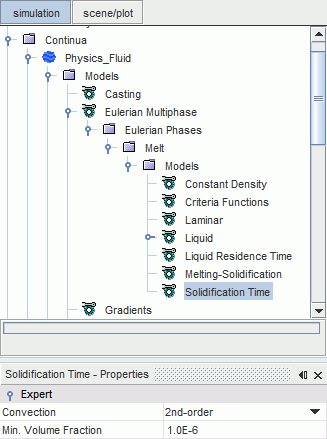Solidification Time
The Solidification Time is the time that is taken to cool down the VOF phase from liquidus temperature to solidus temperature.
This time is computed for every VOF phase for which you activate the Solidification Time model (see Setting Up a Criteria Function). The appropriate critical temperatures must be specified in the Criteria Functions model.

Solidification Time Properties
| Convection | The convection scheme to use. For guidance on selecting a convection scheme, Convective Flux. | |
| 1st-order | First-order convection scheme. | |
| 2nd-order | Second-order convection scheme. | |
| Min. Volume Fraction | The residence time is accumulated only for liquid volume fractions above the specified value. | |
Solidification time is transported only by convection. The initial value is zero everywhere. In every cell in which the VOF phase is between the liquidus and solidus temperatures, a source term that adds the time step to the solidification time is applied at every time step. The scalar value equals the accumulated time that the VOF phase spent within the computational domain in a partly solidified state.
The value of the passive scalar is reset to zero when the phase remelts. That is, when the temperature increases above liquidus temperature after being in the interval between liquidus and solidus temperature for more than one iteration. Hence, the Solidification Time represents only the time that the phase spent between liquidus and solidus temperature for the last time. It is zero for every cell where the temperature is above liquidus temperature or the volume fraction of the phase is below the minimum volume fraction.
Large solidification times indicate hot spots in casting; these spots are commonly due to porosity defects. On the other hand, a very short solidification time for cast iron indicates the presence of white solidified areas in casting.
This quantity is used to compute the Local Solidification Time.